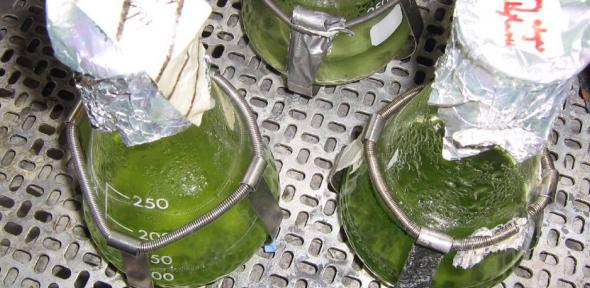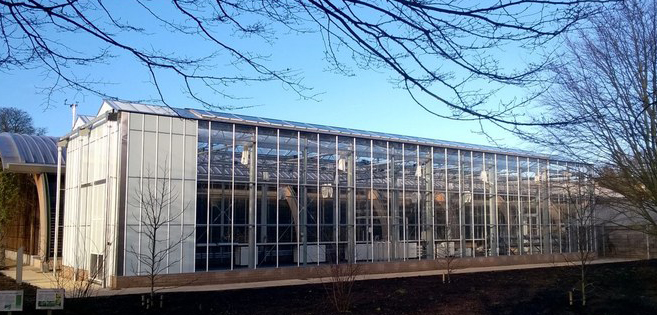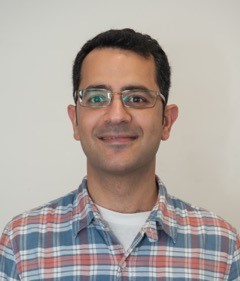
Submitted by Administrator on Wed, 05/12/2018 - 09:53
The challenges involved in eating a nutritious diet vary across the world, but this researcher is working on an ingenious solution with global potential: microalgae. These tiny, single-celled species are unique in producing many compounds vital for a healthy diet. Payam Mehrshahi is trying to add to their repertoire. He’s transferring the ability to make specific vitamins from plants to algae, and in doing so he’s creating the potential to relieve pressure on agricultural land, while simultaneously generating a new source of nutrition.
Q: Where are you from?
A: I was born in Iran and spent the first 11 years of my life in Tehran and Yazd. Then my family moved to Sheffield when my father began studying for a PhD, and I lived there until I went to University. I consider myself as coming from both the UK and Iran.
Q: Tell me something about the food in Iran
A: The food and the smells are the most vivid things I remember from my childhood. My grandfather was a farmer in central Iran, which is a very dry environment. The taste of the broad beans and the smell of the apricots from his farm are firmly lodged in my memory. Somehow the apricots from the supermarkets here never match up.
Q: Why are you here?
A: I’m interested in vitamin biosynthesis in photosynthetic organisms, in other words, how plants and algae produce vitamins. I started my PhD research looking at the biosynthesis of vitamin B9 - more commonly called folate - and vitamins A and E in plants. Then I became interested in how I could use microscopic algae, or microalgae, to further study the production pathways and the movement of these vitamins. Professor Alison Smith here in Cambridge had one of the leading research groups in this area, which was making interesting findings in vitamin biosynthesis in microalgae. After a conversation with her I saw that our interests were very well aligned, and I could pursue what I wanted to do in her group. I joined Cambridge’s Department of Plant Sciences in 2015 and am currently a senior research associate.
Q: What’s your research about?
A: I’m enhancing pathways that currently exist in microalgae, to increase their capacity for production of vitamins like carotenoids. I started by trying to understand how microalgae and plants make and accumulate these compounds, and how production in these organisms could be improved. Then I looked at how aspects of this process can be transferred into specific microalgae that can be easily cultivated and studied in the laboratory.

Algae being grown in the lab
At the moment I’m producing strains of algae that have the potential to be grown at scale in facilities like the Algal Innovation Centre in Cambridge’s Botanic Garden. When we can do this, then we need to work out how to extract the compounds effectively at scale. Sometimes the amount of a compound we can make in a lab setting doesn’t translate directly to what is achievable on a larger scale.

The Algal Innovation Centre, Cambridge
I’m also creating pathways that don’t normally exist in microalgae to produce medicinal compounds. Pharmaceutical companies are collaborators in this work. Together we aim to reduce our dependence on medicinal plants that are often low yielding, and sometimes endangered.
Q: How does this relate to global food security?
A: Deficiencies in certain micronutrients are a big issue in many countries. When we talk about global food security it’s not just about making sure everyone has enough food, but that they also have adequate nutrition for an active and healthy life. In some places there isn’t enough food, but even where there is, the vital micronutrients may be deficient because people aren’t eating a varied diet. Algae is interesting because it doesn’t need fertile land to grow, so it can be cultivated in environments unfavourable for crop cultivation, like ponds. If we can produce important vitamins without agricultural land, we could free up that land for the production of other food crops. This process could help us to provide more nutritious food globally.
Microalgae are already being grown in Iceland using the free geothermal heat, and around the globe using free energy from the sun to produce carotenoids. One carotenoid called astaxanthin has a multitude of uses, including as a crucial part of the feed used in the aquaculture industry to give salmon its pink colour. Another, beta-carotene, is used as a food colouring and it’s also an important vitamin for eye health.
Q: Where are you going?
A: In November I’m travelling to Iceland to visit Matís, a research institute that conducts leading research, innovation and education programmes aligned with the food and biotechnology industries. I’ll be meeting Matís partners to discuss our shared interest in developing alternative sustainable and cost-effective feed ingredients for the aquaculture industry. Globally, aquaculture is seeing an unprecedented growth to meet the demand for seafood.
Matís is a partner, alongside the University of Cambridge, in the pan-European EIT Food programme. This has allowed us to collaborate and seek funding to find solutions for the aquaculture industry, with algae being the main component. We think our microalgae-enriched feed additives will reduce the increasing reliance on non-sustainable soy and fish-meal imports. Our aim is to strengthen the aquaculture industry and deliver major economic benefits, and ultimately to contribute to improved food security.
Q: Do you feel part of something bigger than yourself?
A: Coming from Iran, I’ve seen how nutritious food can impact the health of populations. I became a plant scientist because I could see the possibilities for making a positive impact on health in various locations in the world. Throughout my career I’ve been interested in how to translate my work into practical applications to make a real difference. It’s easy to get very focused on the minute details of research, but actually stepping back and remembering what drew me to the research in the first place is very important.

Q: What’s the one piece of advice you’d give to others who want to follow in your footsteps?
A: My parents always told me to do what I was interested in and passionate about. It’s easy to say, but often we’re pulled in other directions by expectations, or what’s happening around us. Sometimes it means you’re not following a well-defined path. But if something interests me and I find the right place to study it, I try to find a way to get there.
Q: What would make the world a better place?
A: If people tried to be more understanding of others. We all need to be more accepting of people regardless of their race, their background, or their upbringing.

